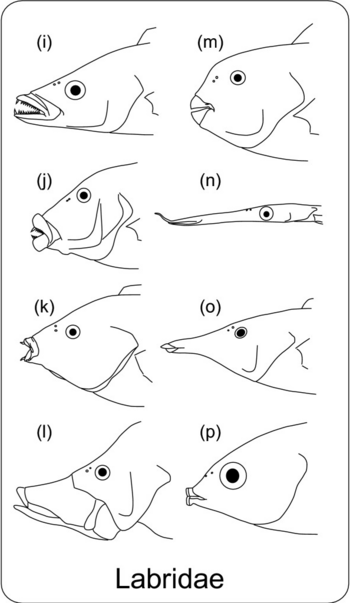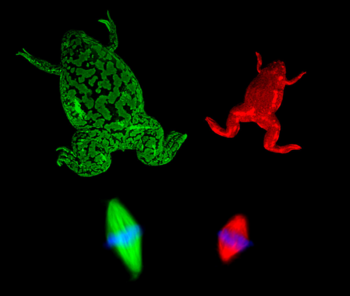Comparative biology: Difference between revisions
Jump to navigation
Jump to search



imported>Daniel Mietchen (+image) |
mNo edit summary |
||
| Line 2: | Line 2: | ||
<!-- Text is transcluded from the BASEPAGENAME/Definition subpage--> | <!-- Text is transcluded from the BASEPAGENAME/Definition subpage--> | ||
{{Image|Labrid skulls.png|left|350px|[[Anatomical variability|Diversity]] of the [[skull]] in the [[Labridae|labrid fish]]. (i) [[Cheilinus celebicus]], feeds on small [[fish]]es and [[invertebrate]]s, (j) [[Hemigymnus melapterus]], feeds on invertebrates in sand, (k) [[Anampses geographicus]], feeds on small [[exoskeleton|hard-shelled]] invertebrates, (l) [[Epibulus insidiator]], engulfs [[crustacean]]s and small fishes, (m) [[Chlorurus microrhinos]], feeds on the [[epilithic]] [[alga]]l matrix of [[coral reef]]s, (n) [[Siphonognathus argyrophanes]], feeds on small invertebrates picked from [[weed]]s or the [[substratum]], (o) [[Gomphosus varius]], feeds on small [[benthic]] crustaceans, (p) [[Labrichthys unilineatus]], a [[coral polyp|coral-polyp]] eater.}} | {{Image|Labrid skulls.png|left|350px|[[Anatomical variability|Diversity]] of the [[skull]] in the [[Labridae|labrid fish]]. (i) [[Cheilinus celebicus]], feeds on small [[fish]]es and [[invertebrate]]s, (j) [[Hemigymnus melapterus]], feeds on invertebrates in sand, (k) [[Anampses geographicus]], feeds on small [[exoskeleton|hard-shelled]] invertebrates, (l) [[Epibulus insidiator]], engulfs [[crustacean]]s and small fishes, (m) [[Chlorurus microrhinos]], feeds on the [[epilithic]] [[alga]]l matrix of [[coral reef]]s, (n) [[Siphonognathus argyrophanes]], feeds on small invertebrates picked from [[weed]]s or the [[substratum]], (o) [[Gomphosus varius]], feeds on small [[benthic]] crustaceans, (p) [[Labrichthys unilineatus]], a [[coral polyp|coral-polyp]] eater.}} | ||
{{Image|Xenopus laevis and tropicalis with mitotic spindles JCB.png|right|350px|[[Mitotic spindle]]s (bottom) are about 30% longer in [[Xenopus laevis]] (green) than in its smaller, faster-breeding relative, [[Xenopus tropicalis|X. tropicalis]] (red).}} | {{Image|Xenopus laevis and tropicalis with mitotic spindles JCB.png|right|350px|[[Mitotic spindle]]s (bottom) are about 30% longer in [[Xenopus laevis]] (green) than in its smaller, faster-breeding relative, [[Xenopus tropicalis|X. tropicalis]] (red).}}[[Category:Suggestion Bot Tag]] | ||
Latest revision as of 11:00, 31 July 2024

(CC) Image: Mabuchi et al., 2007
Diversity of the skull in the labrid fish. (i) Cheilinus celebicus, feeds on small fishes and invertebrates, (j) Hemigymnus melapterus, feeds on invertebrates in sand, (k) Anampses geographicus, feeds on small hard-shelled invertebrates, (l) Epibulus insidiator, engulfs crustaceans and small fishes, (m) Chlorurus microrhinos, feeds on the epilithic algal matrix of coral reefs, (n) Siphonognathus argyrophanes, feeds on small invertebrates picked from weeds or the substratum, (o) Gomphosus varius, feeds on small benthic crustaceans, (p) Labrichthys unilineatus, a coral-polyp eater.
Diversity of the skull in the labrid fish. (i) Cheilinus celebicus, feeds on small fishes and invertebrates, (j) Hemigymnus melapterus, feeds on invertebrates in sand, (k) Anampses geographicus, feeds on small hard-shelled invertebrates, (l) Epibulus insidiator, engulfs crustaceans and small fishes, (m) Chlorurus microrhinos, feeds on the epilithic algal matrix of coral reefs, (n) Siphonognathus argyrophanes, feeds on small invertebrates picked from weeds or the substratum, (o) Gomphosus varius, feeds on small benthic crustaceans, (p) Labrichthys unilineatus, a coral-polyp eater.

(CC) Image: CZ:Ref:Brown 2007 Xenopus tropicalis egg extracts provide insight into scaling of the mitotic spindle
Mitotic spindles (bottom) are about 30% longer in Xenopus laevis (green) than in its smaller, faster-breeding relative, X. tropicalis (red).
Mitotic spindles (bottom) are about 30% longer in Xenopus laevis (green) than in its smaller, faster-breeding relative, X. tropicalis (red).